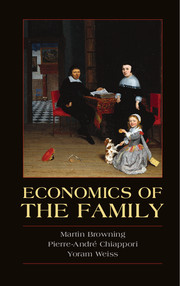Book contents
- Frontmatter
- Contents
- List of Tables
- List of Figures
- Acknowledgments
- Introduction
- PART I MODELS OF HOUSEHOLD BEHAVIOR
- PART II EQUILIBRIUM MODELS OF THE MARRIAGE MARKET
- 7 Matching on the Marriage Market: Theory
- 8 Sharing the Gains from Marriage
- 9 Investment in Schooling and the Marriage Market
- 10 An Equilibrium Model of Marriage, Fertility, and Divorce
- 11 Children and Family Structure
- Author Index
- Subject Index
10 - An Equilibrium Model of Marriage, Fertility, and Divorce
Published online by Cambridge University Press: 05 July 2014
- Frontmatter
- Contents
- List of Tables
- List of Figures
- Acknowledgments
- Introduction
- PART I MODELS OF HOUSEHOLD BEHAVIOR
- PART II EQUILIBRIUM MODELS OF THE MARRIAGE MARKET
- 7 Matching on the Marriage Market: Theory
- 8 Sharing the Gains from Marriage
- 9 Investment in Schooling and the Marriage Market
- 10 An Equilibrium Model of Marriage, Fertility, and Divorce
- 11 Children and Family Structure
- Author Index
- Subject Index
Summary
This chapter provides a simple model of the marriage market that includes fertility, divorce, and remarriage and addresses some of the basic issues associated with the higher turnover in the marriage market. For this purpose, we introduce search frictions, heterogeneity, and unexpected shocks to match quality. The model is simple enough to identify the welfare implication of increasing turnover. The main result is that the prospects of remarriage generate multiple equilibria due to a positive feedback whereby a higher aggregate divorce rate facilitates remarriage, which, in turn, raises the incentives of each couple to divorce. Moreover, when multiple equilibria exist, an equilibrium with higher divorce and remarriage rates generates higher expected welfare for all adult participants in the marriage market. This holds even though parents internalize the negative impact of divorce on their children. This result is a direct outcome of the positive search externalities that are embedded in the model. The main lesson is that a high aggregate divorce rate can be beneficial because it facilitates the recovery from negative shocks to match quality, allowing couples to replace bad marriages by better ones. In this chapter we make the strong assumption that conditional on marital status, the welfare of children is exogenous. A subsequent chapter will introduce postdivorce transfers between partners that can mitigate the negative impact of divorce on children.
- Type
- Chapter
- Information
- Economics of the Family , pp. 414 - 437Publisher: Cambridge University PressPrint publication year: 2014



